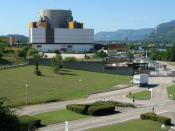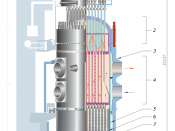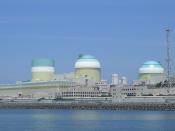Nuclear Power
Producing energy from a nuclear power plant is very complicated. The process of nuclear energy involves the fission of atoms, the release of energy from fission as heat, and the transfer of heat to electricity in power plants.
The process of splitting the atom is called nuclear fission. Fission can take place in many different kinds of atoms. This explanation uses Uranium - 235, the atom most commonly used in nuclear reactors. The Uranium atom has many protons, thus making it unstable. Since the nucleus of the atom is so unstable it wants to split itself apart, causing a spontaneous fission. When the nuclei of a Uranium atom splits apart, it splits into two atoms. Commonly the nucleus splits into Barium and Krypton; however, it can split into any two atoms as long as the number of protons equals the original amount of the protons found in the Uranium. In addition, a mass amount of energy is released along with two or three neutrons. It is these neutrons that can begin a chain reaction, each neutron that is given off could collide with another Uranium atom splitting it apart. Each of these fissioning atoms releases a very large amount of energy, and some more neutrons.
This process continues causing a chain reaction withut any outside assistance, and the Uranium has 'gone critical'(Martindale, 794-195). This chain reaction is the basis for how nuclear power is made.
The amount of the energy that is given off in nuclear fission is astronomical. To equal the amount of energy given off when splitting some uranium the size of a golf ball, one would have to burn approximately twenty-five train cars full of coal. Presently, the planet contains twenty-five times more nuclear fuel compared to fossil fuel. On average, an atomic power...


